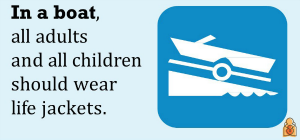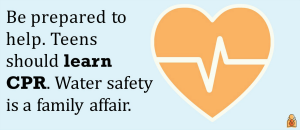Once your child becomes a teenager, water safety becomes even more challenging. Even if adolescents have completed a
swim program and are confident in the water, many enjoy hanging out with friends at the pool or beach—away from your supervision.
While childhood drowning risk decreases after age 4, it actually goes up again during a child's teen years. This is true even among strong swimmers.
Why does the drowning risk rise for teens?
The risk of drowning for adolescents likely increases for a number of reasons, including:
-
Teens are more likely to overestimate their skills and underestimate dangerous situations. Although they often lack experience, adolescents tend to feel invincible. The
part of the brain that controls complex decision-making and impulse control is still developing at this age, making teens more likely to take risks. In addition, teens typically feel like they are being judged by their peers and may try to keep up with them or impress them even if they don't have the swim skills and experience.
-
Drinking and drowning dangers. The risks of
substance use become a bigger factor during adolescence. About
two-thirds of students have tried alcohol by 12th grade, for example. Research shows
alcohol is a leading risk factor in drownings; drinking alcohol while swimming or boating is a major cause of 30-70% of recreational water deaths among U.S. adolescents.
Teen drowning risk increases in lakes, rivers and other natural water.
While younger children in the U.S. are more likely to drown in swimming pools, teens are more likely to drown in natural bodies of water like lakes, rivers, oceans, ponds and other
natural water.
How to keep your teen safe in and around water:
The American Academy of Pediatrics (AAP) recommends families use layers of protection against drowning.
Here are some of the most important things to keep in mind once children enter adolescence:
-
Make sure everyone learns how to swim. If your family hasn't been able to learn basic swim and water survival skills yet, it's not too late! Many organizations offer
swim lessons specifically geared toward teens and adults. Your teen may even enjoy lessons enough to continue with lifeguard training, reinforcing their water safety skills (and, as a bonus, preparing themselves for a possible summer job)!
-
Continue to supervise; it saves lives. Remember that knowing how to swim will not "drown proof" a child of any age. Even among older children and teens, most childhood drownings happen when there is no adult supervision. Make sure your teen knows to swim only where there are lifeguards on duty and to never swim alone. Urge them to use the buddy system, even when swimming with large groups of friends.
-
Teach your teen to always enter the water for the first time feet first. It is important to know the water's depth beforehand. Also, going in feet first helps them know whether there are underwater hazards like large rocks that can't be seen from the surface. Make sure they look for―and follow―any "No Diving" instructions posted. Diving into unsafe water can lead to serious, and sometimes permanent,
spinal injuries.
-
Choose natural water swimming spots carefully. Teens should understand that swimming in a river or ocean can be a lot different from swimming in a pool. Before going into natural water like oceans and lakes, teach your teen to:
stick with designated swimming areas with lifeguards.
avoid beaches with large waves, a powerful undertow or
rip currents.
stay away from areas where there are boats and people fishing.
-
 Always wear life jackets when boating. Adolescents should always wear US Coast Guard-approved
life jackets whenever they are in or on boats, jet skis and other watercraft. Adults should wear theirs when boating, too, to be good role models and be ready to help in case of emergency. Make sure your teen knows never to rely on inflatable tubes and rafts as life preservers.
Always wear life jackets when boating. Adolescents should always wear US Coast Guard-approved
life jackets whenever they are in or on boats, jet skis and other watercraft. Adults should wear theirs when boating, too, to be good role models and be ready to help in case of emergency. Make sure your teen knows never to rely on inflatable tubes and rafts as life preservers.
-
Stay sober on the water. Talk to your teen about how alcohol and drugs make being in or on the water more dangerous. Alcohol use while boating increases drowning risks among passengers as well as boat operators. Explain that alcohol interferes with swimming skills, balance, coordination and judgment, and can increase the risk of hypothermia in the water. Adults should also avoid alcohol while supervising children or before swimming, boating or water skiing.
-
Be aware of cold-weather water hazards. Remind your teen not to walk or ride snowmobiles on thin or thawing ice.
-
 Everyone should know how to respond to a drowning emergency. Everyone―including parents, caregivers and older children and teens―should learn CPR and safe rescue techniques to respond when there is trouble in the water. They should also know how to get help. Encourage your child's high school to provide CPR training during health class.
Everyone should know how to respond to a drowning emergency. Everyone―including parents, caregivers and older children and teens―should learn CPR and safe rescue techniques to respond when there is trouble in the water. They should also know how to get help. Encourage your child's high school to provide CPR training during health class.
Remember:
Hundreds of teens, including some who are good swimmers, drown each year in the U.S. But, these tragedies are preventable. Talk with your pediatrician during your teen's annual wellness exams about staying safe in and on the water.
More information